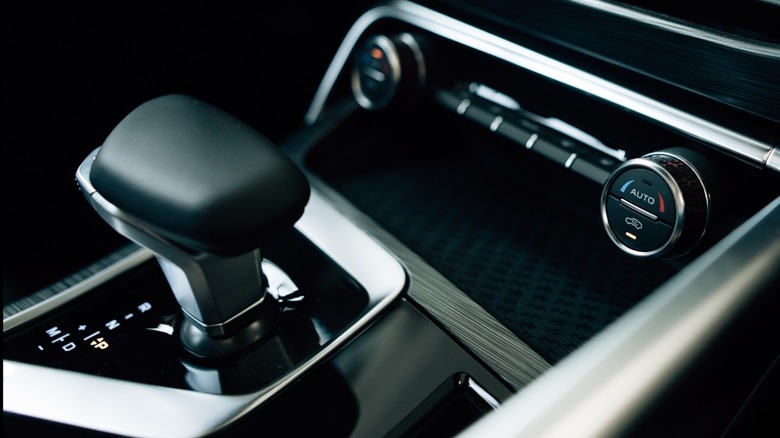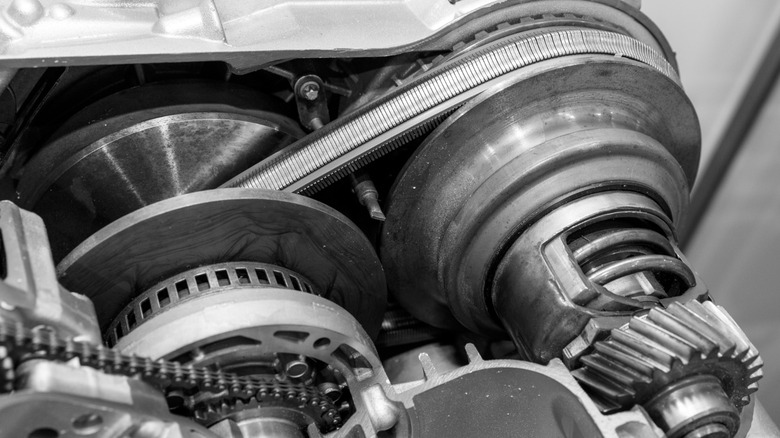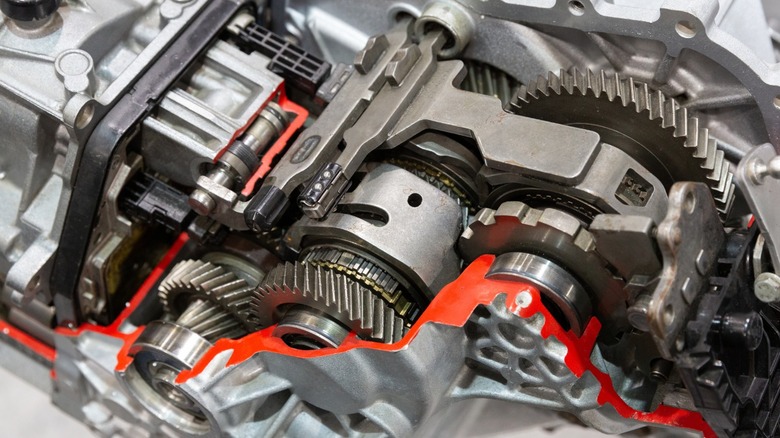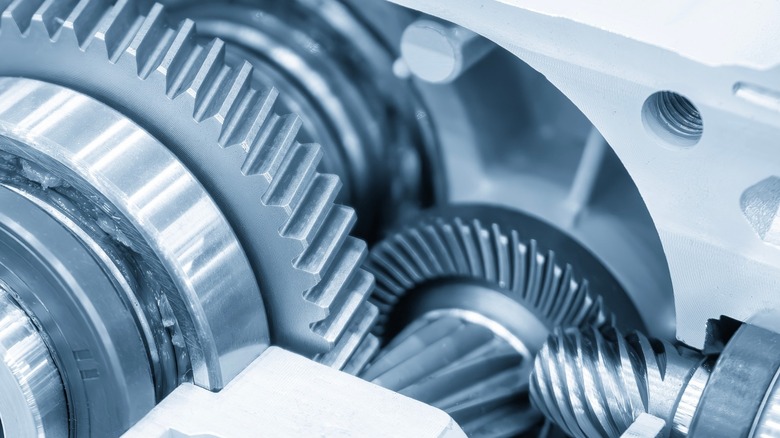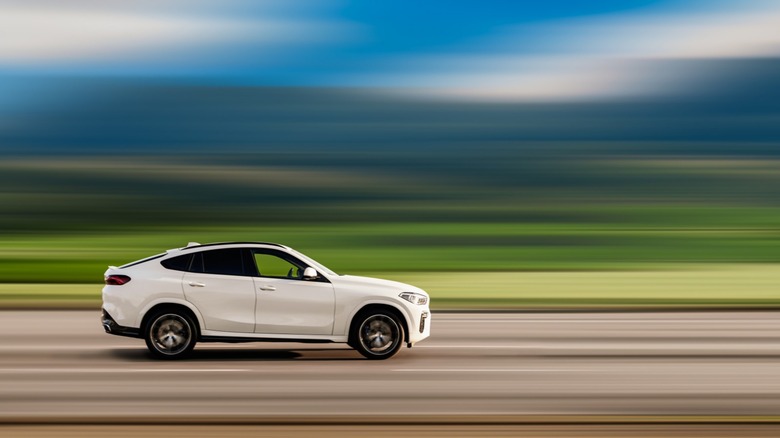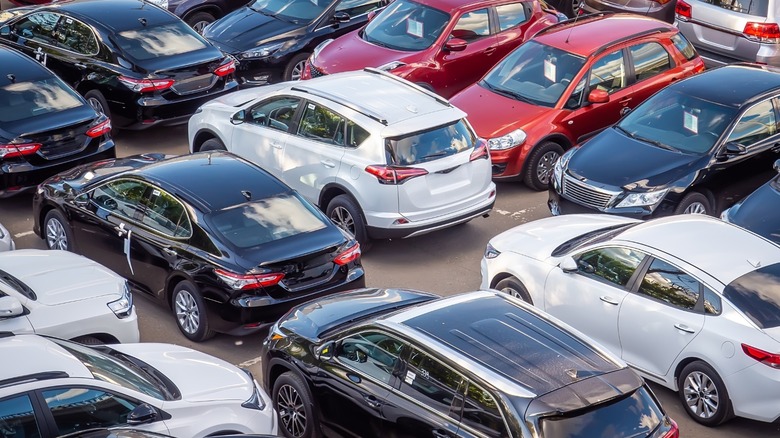CVT Vs. DCT Transmission: What's The Difference?
If you've been shopping for a new vehicle or you're a budding car enthusiast, you probably already know that you can pick between an automatic and manual transmission. However, did you know that there are several types of automatic transmissions that you can choose from? Aside from the traditional torque converter automatic, there's the CVT and the AMT.
The CVT, which means continuously variable transmission, uses a set of pulleys to give your car an infinite number of gear ratios. On the other hand, the AMT, which means automated manual transmission, has a traditional manual gearbox. But instead of requiring the driver to step on the clutch and row their own gears, it uses a computer-controlled servo to actuate the clutch and change the gears. A DCT, or dual-clutch transmission, is a type of AMT, which, as the name suggests, uses two clutches instead of one.
Some enthusiasts say that one type of transmission is superior to the other, but in the end, it all boils down to your preference. This is especially true with technological advancements, which have made both the CVT and AMT as reliable as the traditional torque converter. But if you're picking out a car and can't decide which transmission to go for, here's the low-down on CVTs and DCTs and the difference between the two.
What is a CVT?
As we said earlier, CVT stands for continuously variable transmission, and it uses a pulley system instead of gears to put power down from the engine to the road. It consists of a metal chain or belt connecting two conical pulleys. These cones allow the connecting pulleys to change their diameter, which changes the CVT's output ratio. Because of this setup, this transmission has an infinite number of gear ratios, allowing the car's computer to pick the perfect ratio based on your driving condition.
Because these pulleys change their diameter gradually, CVTs tend to be smoother than other types of transmissions that use a fixed number of gears. And no matter what some car enthusiasts say, a CVT is still the fastest transmission that you can get in a car because it can hold the engine at peak power while changing the gear ratio. That means your car is not losing power when you're going from 0-200 mph as it can stay at its optimal engine speed even as the CVT goes from a low to a high ratio.
Despite that, CVTs do have some disadvantages. For example, it's smooth operation means that you will not feel your car change gears, reducing the driving dynamics you would often expect from a car when you push its performance. It also makes your engine sound like a drone, especially because it keeps your engine rpm at a specific range (which is likely its peak power output) when accelerating or driving at high speeds.
Some manufacturers add paddle shifters and "shift points" on CVTs to simulate the feel of traditional manual transmissions. However, it still doesn't eliminate the rubber-band feel you get when you're accelerating hard on a CVT-equipped car.
What is a DCT?
A dual-clutch transmission is different from other types of automatic transmissions in that it uses the clutch and gear setup of a manual — that's why it's often called an automated manual transmission. However, aside from using servos to control the clutches and gear shifts, what makes the DCT different from the traditional manual transmission is the addition of a secondary clutch and set of gears.
Whenever you switch gears on a manual transmission, you have to step on the clutch to release the connection between the engine and the transmission. This cuts the power output to the transmission and the wheels, allowing the next gear you need to engage to get up to speed. This ensures smooth gear changes, but you momentarily lose power when shifting gears. This means you're losing some speed, and you'll feel the gear change, especially at slower speeds.
On the other hand, DCTs have the odd-numbered gears grouped together in one set and the even-numbered gears on another. Suppose you're currently driving in second gear and you need to switch gears, either to first or third. Before you switch gears, the transmission pre-engages the odd-numbered gears so that they're running at the same speed as the even-numbered gears. When the gear change occurs, the transmission switches clutches and you're at your desired gear without the need to cut power from the engine to the wheels, so your engine is continuously putting out power to the wheels and you won't feel the gear change.
Gears vs. pulleys
The primary difference between CVTs and DCTs is how they deliver power to your wheels. CVTs use conical pulleys, allowing it to select an infinite number of gear ratios between the maximum and minimum ratio. This ensures that your car's computer can always pick the best ratio based on your speed, engine output, and driving condition.
Because of this, your car would typically drive much smoother compared to vehicles equipped with other types of transmissions. It's also smaller, lighter, and much simpler versus DCTs, making it cheaper to build. All these characteristics make it perfect for economy car buyers who prioritize getting a reliable form of transportation that will get them from point A to point B in relative comfort.
On the other hand, even though DCTs only have a set number of gears, its two clutches and pre-selected gears make instantaneous gear changes. This enhances throttle response, making it perfect for cars that prioritize performance. While nothing cannot replace the feeling of rowing your own gears with a manual transmission, the responsiveness and control that DCTs offer gives those looking for the sportiness of a manual and the convenience of an automatic the best of both worlds.
Fuel economy vs. driving dynamics
Because of the way CVTs work, it's associated with delivering great fuel economy, so you often find them in economy cars. For example, Honda started using CVTs in 1995 for its Honda Civic HX, and nearly every Honda model you can get today could be equipped with a CVT. Thankfully, the sport Honda Civic Si and Type R trims still come with a manual transmission.
On the other hand, DCTs deliver fast and sharp gear changes that you can feel, especially when you're pushing your car's performance. This responsiveness makes DCT-equipped vehicles suited for spirited driving, especially as its two clutches ensure you will never have to lose engine power as your car quickly rows through the gears. And when you need to accelerate hard, like when you're overtaking or taking advantage of a wide, open road, DCTs can downshift in a flash to deliver the torque you need to push the car harder.
While not as fuel efficient as a CVT, DCTs still deliver better gas mileage than traditional automatics, and both typically outperform manual transmissions. Some examples of vehicles with a DCT include the BMW M2, Hyundai Elantra N, and Volkswagen Golf R.
City driving vs. highway driving
City driving is often associated with stop-and-go traffic, and this is where the CVT shines. That's because it can set the optimal gear ratio for your drivetrain, no matter what the traffic situation is. Even when you must frequently stop or drive slowly, your car will crawl through traffic relatively smoothly with just minor gear ratios. DCTs, however, would have to frequently switch between first, second, and maybe even third gear. In fact, this one of the things you should avoid in a DCT car — inching or crawling your car in heavy traffic.
On the other hand, DCTs are perfectly suited to highway driving. Six- and seven-speed DCTs can achieve high fuel efficiency with these high gear ratios, and the seamless shifts allow you to maximize your engine power as your take advantage of the open road. And even though a CVT keeps your engine at its maximum power band, this often results in a droning sound and lack of feedback, making them unenjoyable to drive at high speeds.
The better transmission depends on your preference
CVTs often get a bad reputation from car enthusiasts, especially because they lack the driving feel and dynamism that people expect from performance cars. However, this is just a side effect of the constant engine rpms that CVTs deliver, allowing your car to perform at its maximum efficiency. If you're the average driver who simply needs a car that will take you where you need to go on a daily basis, then there's absolutely nothing wrong with getting a CVT. It's cheap, effective, and fuel efficient — things you're likely looking for if you're on a budget.
On the other hand, DCTs deliver the excitement and performance of a manual transmission while still giving you the comfort and convenience of a traditional automatic. While they're not as fuel efficient as CVTs and are not that suitable for city driving, it's still a great option if you want to add a little bit more fun in your daily drive.
In the end, it all depends on your preference. Are you prioritizing fuel economy and cost effectiveness, or do you want something that will get your heart pumping when you get on the freeway? Either way, both transmission types will get you to where you need to be.
